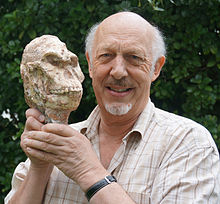Ronald J. Clarke
Ronald John "Ron" Clarke (* 1944 ) is an in South Africa living British paleoanthropologist , who became internationally known in the art as the discoverer of " Little Foot ," an unusually complete fossil of the genus Australopithecus , which so far none of the known Australopithecus - species was assigned .
Ron Clarke discovered the fossil SK 847 as early as 1969 in Swartkrans , a 1.8 to 1.5 million year old skull fragment that is initially classified as a " robust Australopithecus ", but today mostly as Homo ergaster , but occasionally also as Homo habilis .
Clarke was also involved in the discussion about the delimitation of Homo rudolfensis from Homo habilis , which arose after the fossil OH 65 was found in the Olduvai Gorge .
Clarke worked for a long time at the University of the Witwatersrand as a restorer, but was fired in 1998 by Lee Berger , the head of the department of paleoanthropology, because his research was "old-fashioned and too expensive". He was initially only able to continue his research - especially in connection with the uncovering of “Little Foot” - because he was recruited by Reiner Protsch von Zieten for his work group at the Johann Wolfgang Goethe University in Frankfurt am Main . Three years after his release, the Witwatersrand University set up a separate department each for Clarke and Berger, so that Clarke could return to South Africa. Until the end of 2018, Clarke prevented Lee Berger from gaining access to his own research and publications about Little Foot .
literature
- Jörn Auf dem Kampe: The treasure of Sterkfontain. In: Geo , 06/2011, pp. 78-92
Web links
- University of the Witwatersrand: former website of Ronald Clarke (as of June 2014)
- Full Australopithecus Fossil Found in South Africa. On: washingtonpost.com of December 10, 1998
- talkorigins.org Detailed description of Little Foot
Individual evidence
- ^ Reiner Protsch von Zieten , Ronald J. Clarke: The oldest complete skeleton of an Australopithecus in Africa (StW 573). In: Anthropologischer Anzeiger. Volume 61, 2003, pp. 7-17
- ↑ B. Bower: Ancient ancestor reveals skeletal stamina. Science News from December 19, 1998, full text (PDF; 42 kB) ( Memento from February 10, 2012 in the Internet Archive ) (in English)
- ↑ Timothy C. Partridge, John Shaw, David Heslop, Ronald J. Clarke: The new hominid skeleton from Sterkfontein, South Africa: age and preliminary assessment. In: Journal of Quaternary Science. Volume 14, No. 4, 1999, pp. 293-298, doi : 10.1002 / (SICI) 1099-1417 (199907) 14: 4 <293 :: AID-JQS471> 3.0.CO; 2-X
- ^ Ron J. Clarke, F. Clark Howell : Affinities of the Swartkrans 847 hominid cranium. In: American Journal of Physical Anthropology. Volume 37, No. 3, 2005, pp. 319-335, doi : 10.1002 / ajpa.1330370302
- ↑ humanorigins.si.edu Brief description of the SK 847 fossil on the Smithsonian Institution website
- ↑ talkorigins.org : Brief description of the fossil OH 65
- Jump up ↑ Robert J. Blumenschine, Charles R. Peters, Fidelis T. Masao, Ronald J. Clarke et al .: Late Pliocene Homo and Hominid Land Use from Western Olduvai Gorge, Tanzania. In: Science . Volume 299, No. 5610, pp. 1217-1221, doi : 10.1126 / science.1075374
- ↑ Suzanne Daley: Solving a 3.5-Million-Year-Old, 3-D Jigsaw Puzzle. On: nytimes.com March 17, 1999
- ↑ After more than 20 years in the hands of one researcher, the nearly complete "Little Foot" hominin skeleton from South Africa will finally be open to other scientists at the end of November. Michael Balter, November 1, 2018
| personal data | |
|---|---|
| SURNAME | Clarke, Ronald J. |
| ALTERNATIVE NAMES | Clarke, Ronald John (full name); Clarke, Ron |
| BRIEF DESCRIPTION | British paleoanthropologist |
| DATE OF BIRTH | 1944 |
